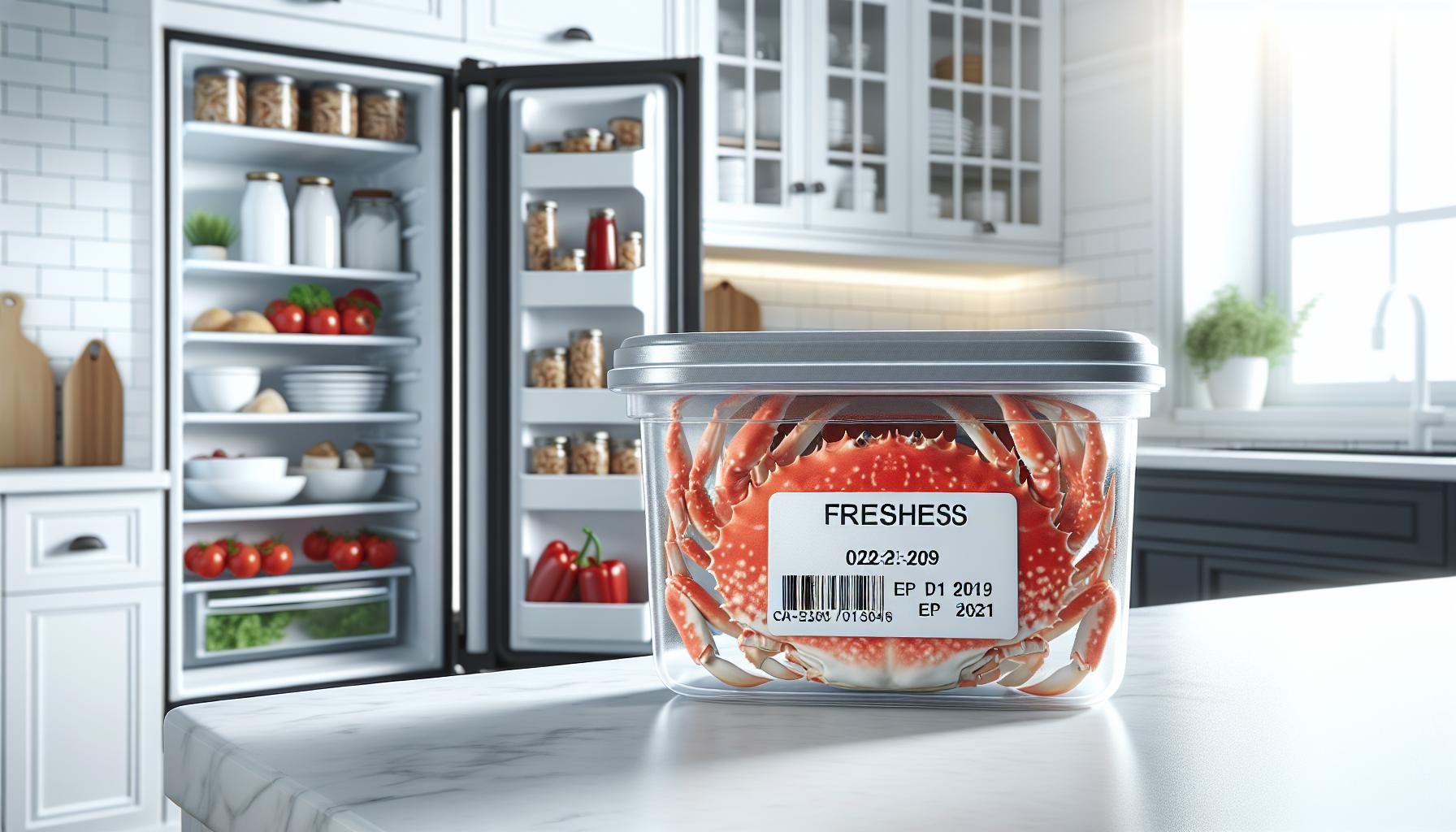Did you know that improperly stored fish can lead to a loss of both flavor and nutrition? Understanding how long fish lasts in the freezer is essential for maintaining its taste and health benefits. Whether you’re a seasoned chef or a home cook, knowing the optimal freezing times ensures that you enjoy fresh, delicious meals while minimizing food waste.
As you dive into the specifics of fish storage, you’ll discover crucial tips that not only enhance your culinary experience but also safeguard your health. With proper guidance, you can confidently stock up on your favorite seafood and make the most of every meal. Curious about the best practices for freezing different types of fish? Let’s unlock the secrets to preserving your catches and maximizing their quality, so you can savor every bite!
How Long Does Fish Last in the Freezer?

Fish can be an excellent source of nutrition and flavor, but understanding how long it lasts in the freezer is crucial to enjoying the best quality. Generally, fish can remain safe to eat indefinitely if kept at 0°F (-18°C) or lower; however, the quality diminishes over time. Most fish types, including fatty varieties like salmon and mackerel, maintain their best quality for about 2 to 3 months when properly frozen. Lean fish, such as cod or haddock, can last up to 6 months without significant loss of flavor or texture.
To maximize the shelf life of fish in the freezer, it’s essential to consider both the type of fish and the method of freezing. Vacuum-sealing is one of the most effective ways to preserve fish, as it removes air that can lead to freezer burn. For items stored in containers or bags, minimizing air exposure is crucial. Always label your packages with the date of freezing to keep track of freshness.
Remember, while fish may still be safe to eat beyond these time frames, quality and flavor can be noticeably affected. Upon thawing, look for signs such as off-smells or unusual textures, which can indicate spoilage. Proper storage and handling will ensure you enjoy your fish dishes at their best, blending safety with delectable taste.
Understanding Freezer Storage Basics for Fish
Frozen fish can be a lifesaver for meal planning, providing a convenient and nutritious option that retains its flavor and texture when stored correctly. Understanding the intricacies of fish storage in the freezer is essential for maintaining quality and ensuring food safety. For starters, it is crucial to freeze fish promptly after purchase to lock in freshness. The general rule of thumb is to freeze fish within a day of buying it, or within two days if it’s already been previously frozen. Many fish types-especially those high in fat, like salmon or mackerel-can lose their optimal taste and texture if stored for extended periods.
To preserve fish quality, ideal freezer management includes a few key practices. Use vacuum-sealed bags or airtight containers to minimize air exposure, which can lead to freezer burn-a condition that negatively impacts the flavor and texture of your fish. Consider labeling all packages with the freezing date to monitor storage time effectively. As a guideline, most fatty fish should ideally be consumed within 2 to 3 months for the best experience, while lean fish can retain quality for up to 6 months.
It’s also important to maintain a consistent freezer temperature of 0°F (-18°C) or lower. Temperatures above this can compromise both the quality and safety of your fish. Remember, while fish kept at this temperature might remain safe to eat indefinitely, the quality can significantly diminish over time. For optimal results, always acclimate your freezer to maintain a steady temperature and check that your thermometer is functioning correctly. By observing these guidelines, you can enjoy the best of your frozen catch while ensuring safety and flavor go hand-in-hand.
Determining Fish Freshness Before Freezing

To ensure that the fish you intend to freeze remains fresh and safe for consumption, it’s crucial to assess its quality before putting it in the freezer. Fresh fish should exhibit certain unmistakable characteristics. First and foremost, check for a bright and clear appearance; the flesh should be moist and shiny, reflecting a healthy sheen. Additionally, the eyes of the fish should be clear and bulging. Dull, sunken eyes are indicative of aging fish. A fresh fish will also have a mild ocean smell, rather than a strong fishy odor, which is a telltale sign of spoilage.
When handling the fish, pay attention to the texture. The flesh should be firm and return to its original shape when pressed gently. If the fish feels mushy or leaves an indentation when you touch it, it’s past its prime. It’s also important to inspect the gills; healthy fish should have bright red or pink gills, while brown or gray gills suggest that the fish is no longer fresh. If you’re purchasing whole fish, these are key indicators of freshness that can greatly affect the quality after freezing.
Before freezing, it’s best to prepare your fish by cleaning and gutting it, followed by immediate cooling if you’ve just caught it. This rapid cooling prevents bacteria from proliferating and preserves freshness. If you plan to freeze fish fillets, doing so the same day of purchase is ideal. Remember, freezing does not kill bacteria; it only slows their growth. Therefore, ensuring you start with high-quality, fresh fish is essential for maintaining taste and safety after thawing.
Best Practices for Freezing Different Fish Types
Freezing fish properly is crucial for retaining its quality, flavor, and nutrition. Different types of fish require tailored freezing methods to ensure optimal preservation. Fatty fish like salmon and mackerel respond best to quick freezing techniques, while leaner varieties, such as cod or haddock, require slightly different handling to maintain their texture and flavor profile over time.
Start with fatty fish; it’s often recommended to wrap it tightly in plastic wrap or aluminum foil, followed by placing it in an airtight freezer bag. The goal is to minimize exposure to air, which can lead to freezer burn. For fatty fish, aim to consume it within 2 to 3 months for the best flavor and texture. In contrast, lean fish can last a bit longer in the freezer, typically up to 6 months, if wrapped properly in freezer paper and sealed in a container. This helps prevent moisture loss, which can affect the fish’s quality when it defrosts.
For shellfish, such as shrimp or scallops, it’s essential to freeze them in their shells if possible, as this protects their moisture content. If already shelled, place them in a single layer on a baking sheet until frozen, then transfer to a vacuum-sealed bag or an airtight container. They can last up to 3 months in the freezer without significant loss of flavor or texture.
Pay close attention to how you label your fish! Always write the type of fish and the date it was frozen on the packaging. This simple step helps you manage your inventory and ensures you use older fish first. Remember, seasoned fish can also be frozen, but allow for some time after marinading for the flavor to set. When freezing prepared or seasoned fish, use the same wrapping techniques to keep it fresh. This way, you ensure that your meals are packed with flavor, even after months in the freezer.
How to Package Fish for Freezing
When it comes to extending the shelf life of fish, the way you package it before freezing plays a pivotal role in retaining its taste, texture, and nutritional value. Proper packaging minimizes air exposure, which can lead to freezer burn, a common issue that ruins flavor and quality. Ensuring your fish is adequately wrapped starts with selecting the right materials: you can use plastic wrap, aluminum foil, or vacuum-sealed bags, all of which create a tight seal around the fish.
For optimal results, follow a systematic approach when packaging fish for freezing. First, pat the fish dry with paper towels to remove excess moisture, which can contribute to ice crystals forming during freezing. Next, tightly wrap each fillet or whole fish in plastic wrap or aluminum foil, ensuring no part is exposed to air. For added protection, place the wrapped fish into an airtight freezer bag. Squeeze out as much air as possible before sealing it to create a vacuum effect, which is vital for preventing freezer burn. Always remember to label each package with the type of fish and the date of freezing, making it easy to keep track of freshness.
Consider the type of fish you’re freezing as well. Fatty fish like salmon and mackerel should be frozen at colder temperatures quickly to preserve their moisture and flavor. Wrap them tightly and arrange them flat in the freezer. On the other hand, lean fish can be stored for longer periods if properly portioned and wrapped. For shellfish, freezing them in their shells helps maintain their moisture content. If they are shelled, arrange them in a single layer on a baking sheet until frozen solid, then transfer them to a vacuum-sealed bag.
Finally, it’s crucial to adhere to recommended freezing times: aim to consume fatty fish within 2-3 months and lean fish within 6 months for the best flavor and quality. Following these guidelines when packaging your fish will not only enhance its longevity but also ensure a delightful dining experience when you decide to thaw and cook it.
Ideal Freezer Temperatures for Fish Safety
Freezing fish correctly is not just about throwing it into a freezer; it’s about maintaining its safety and quality throughout its storage life. The ideal temperature for freezing fish is 0°F (-18°C) or lower. At these temperatures, the growth of bacteria and parasites is effectively halted, ensuring that the fish remains safe to eat long after it has been frozen. A reliable freezer that maintains this temperature consistently is crucial for optimal fish preservation.
When freezing, it’s essential to remember that sharp temperature fluctuations can lead to food quality degradation. Avoid overloading the freezer, as this can prevent air circulation and result in uneven cooling. If you’re freezing a large batch of fish, it’s best to spread it out in a single layer on a baking sheet until it’s frozen solid before transferring it to storage bags or containers. This method not only minimizes the time fish spends in temperatures above freezing but also helps maintain its moisture and texture.
For best practices, consider regularly checking your freezer temperature with an appliance thermometer to ensure it remains at safe levels. If you’re unsure whether your fish has been stored at the proper temperature, it’s wise to err on the side of caution and assess its quality upon thawing. Remember that, while freezing can significantly extend the shelf life of fish-fatty fish should ideally be consumed within 2-3 months, while lean fish can be kept for 6 months or more-maintaining those low temperatures is the key to preserving taste and nutrition.
Signs of Spoilage After Freezing Fish
Freezing preserves fish, but it doesn’t make it immune to spoilage. Even properly frozen fish can show signs of deterioration after some time, and recognizing these signs is crucial for ensuring food safety and quality. One of the first indicators of spoilage is a noticeable change in color; high-quality, fresh fish should have a consistent, vibrant hue. If you observe dullness, browning, or a grayish tint, it may be a sign that the fish has begun to deteriorate.
Texture is another critical factor to monitor. Fresh fish should feel firm and resilient to the touch. If the fish appears mushy or has an overly soft texture, it is likely past its prime and could pose health risks. Additionally, beware of any off-putting or sour odors that may develop. Fresh fish should have a mild scent of the sea; any strong or unpleasant smells indicate spoilage and should be taken seriously.
Ice crystals and freezer burn are also common signs of spoilage in frozen fish. Ice crystals forming on the surface can suggest that the fish was not sealed properly during freezing, leading to hydration loss and freezer burn-where the flesh of the fish becomes dehydrated and tough. To avoid freezer burn, ensure that fish is tightly wrapped in moisture-proof packaging before freezing, as this helps maintain both quality and flavor.
If you’re unsure about the state of your frozen fish, conduct a quick check during thawing. If it has retained its color, texture, and odor, it is generally safe to cook and consume. However, if you detect any signs of spoilage from above, it’s best to err on the side of caution and discard the fish to avoid any potential health hazards. Staying vigilant about these signs not only helps in preventing food waste but also ensures that your meals are both safe and enjoyable.
Thawing Fish Safely: Best Methods Explained
To maintain both flavor and safety while preparing previously frozen fish, proper thawing techniques are essential. Thawing fish incorrectly can lead to loss of texture, flavor, and even pose health risks due to bacterial growth if not done properly. To ensure the best results, consider the following safe thawing methods.
Refrigerator Thawing
The most recommended method for thawing fish is to place it in the refrigerator. This method is the safest, though it requires planning ahead. Simply transfer the fish from the freezer to the fridge and let it thaw slowly over 12 to 24 hours, depending on the size of the portion. This low-temperature environment prevents bacterial growth, maintaining the fish’s quality and flavor.
Cold Water Thawing
If you need to thaw fish more quickly, the cold water method is efficient and safe. Ensure the fish is in a sealed plastic bag to prevent water from coming into contact with it. Submerge the bag in a bowl of cold water, changing the water every 30 minutes to keep it cold. Thinner fillets may thaw in as little as an hour, while larger cuts may take two hours or more. This method is quick yet preserves the fish’s quality effectively.
Microwave Thawing
While not ideal, the microwave can also be used to thaw fish when you’re in a hurry. If you choose this method, use the defrost setting and monitor the process closely to avoid partially cooking the fish. Immediately cook the fish after thawing in the microwave to prevent any potential bacterial growth. This method should be a last resort as it can sometimes affect the texture and flavor.
Thawing Tips to Remember
- Avoid room temperature thawing: Never thaw fish on the counter; doing so can invite bacteria and compromise safety.
- Cook immediately after thawing: Especially if using the cold water or microwave methods, cook the fish right after thawing to ensure it’s safe to eat.
- Refreeze only if necessary: If you’ve thawed fish in the refrigerator and it hasn’t been cooked, you can refreeze it safely. However, ice crystals should not form if you are using the cold water or microwave methods.
By following these safe thawing methods, you can ensure your frozen fish stays delicious and safe for your meals.
Maximizing Flavor: Seasoning and Marinading Tips
Unlocking the full potential of frozen fish involves more than just proper storage; seasoning and marinating can transform its flavor profile significantly. Fish naturally has a delicate taste, and with the right techniques, you can enhance its mildness while retaining freshness even after freezing. Accentuating flavors not only makes the dish more enjoyable but can also make the fish taste fresher than it might otherwise when thawed.
One effective way to infuse flavor into your frozen fish is through marination. A good marinade penetrates the fish and can amplify its taste. Consider using a combination of acidic ingredients, such as lemon juice or vinegar, alongside herbs and spices. For instance, a simple marinade can include olive oil, garlic, fresh herbs (like dill, parsley, or cilantro), and a splash of citrus. Allow the fish to marinate for at least 30 minutes before cooking, although longer marination-up to a few hours-can deepen flavors. Always remember to marinate in the refrigerator rather than at room temperature to prevent bacterial growth.
In addition to marinating, seasoning frozen fish properly can greatly enhance its flavor. Before cooking, consider lightly coating the fish with salt and pepper to elevate its natural taste. Spice blends can also add a unique touch; for short-term flavor boosts, you might use Cajun seasoning, Italian herbs, or a blend of smoked paprika and cumin. It’s advisable to season fish just before cooking to prevent it from drawing moisture out and drying out while thawing.
Remember, the key to maximizing flavor is experimentation. Keep a log of your most successful combinations to recreate those standout meals. By investing some time in seasoning and marinading, you can elevate the dish significantly, ensuring that the fish remains both a nutritious and flavorful part of your diet.
How to Recognize Freezer Burn on Fish
Freezer burn is a common issue that can affect the quality of your frozen fish, but recognizing it early can help you salvage your meal and maintain food safety. This undesirable condition occurs when the fish is exposed to air inside the freezer, leading to moisture loss and the formation of ice crystals on the surface. The first sign of freezer burn is the appearance of discolored patches-often white or grayish brown-on the fish’s surface. These areas may feel dry, rough, or leathery compared to the rest of the fish. While freezer burned fish may still be safe to eat, the quality and taste can be significantly compromised.
To minimize the risk of freezer burn, it’s crucial to understand proper packaging techniques before storing your fish. Always use airtight containers or freezer-safe bags, making sure to remove as much air as possible before sealing. For added protection, consider wrapping the fish in plastic wrap or aluminum foil before placing it in a bag or container. Label each package with the date and type of fish, which will not only help you keep track of freshness but also remind you to consume it within the recommended timeframe-generally, fatty fish should be consumed within three months, while lean fish can last up to six months when stored properly.
If you discover freezer burn on your fish after thawing, it’s important not to panic. You can cut away the affected areas before cooking to improve the overall quality. However, it’s best to avoid using fish that has extensive freezer burn, as the taste may be unpalatable. To prevent freezer burn in the future, always utilize your freezer’s best practices, like maintaining a constant temperature of 0°F (-18°C) or lower, and be mindful of how long you store items to retain both taste and nutrition. Recognizing and addressing freezer burn effectively can help ensure that your frozen fish remains a delicious and nutritious option for your meals.
Nutritional Impact of Freezing on Fish
The nutritional preservation of fish during freezing is a crucial consideration for maintaining its health benefits. Freezing fish effectively halts the growth of bacteria and reduces the activity of enzymes, which can degrade both flavor and texture over time. When done properly, freezing can retain up to 90% of a fish’s nutrients, including essential proteins, omega-3 fatty acids, vitamins (such as A and D), and minerals like selenium and iodine.
To lock in these nutrients, it’s important to freeze the fish as soon as possible after catching or purchasing. Fresh fish ideal for freezing should be processed within 24 hours. This means removing any guts, scales, and unwanted parts, followed by thorough cleaning and drying before packaging. Quick freezing at very low temperatures (-20°F or lower) helps prevent the formation of large ice crystals that can cause cellular damage, which affects texture and taste.
Key Nutrients Retained During Freezing
Some of the vital nutrients that are preserved during the freezing process include:
- Protein: Fish is an excellent source of high-quality protein, which remains largely intact during freezing.
- Omega-3 Fatty Acids: These heart-healthy fats are preserved well, contributing to cardiovascular health.
- Vitamins: Important vitamins like A, D, and B12 are retained, supporting overall health and metabolic functions.
- Minerals: Elements such as selenium, which has antioxidant properties, are preserved in frozen fish.
However, it’s important to note that the conditions of storage and duration can affect nutritional quality. Fish stored for an extended period may experience a gradual decline in texture and flavor. For optimal nutritional retention, it is recommended to consume fatty fish within three months of freezing and lean fish within six months. Additionally, utilizing proper thawing methods-such as refrigerating overnight or immersing in cold water-can further help maintain the nutrient quality once you’re ready to cook.
Cooking Tips for Previously Frozen Fish
Cooking fish that has been previously frozen can yield delicious results if approached with care and attention to detail. A fundamental tip is to ensure proper thawing before cooking. For optimal texture and flavor retention, it’s best to thaw the fish slowly in the refrigerator, allowing it to defrost overnight. If you’re short on time, you can use a sealed plastic bag and submerge it in cold water for quicker thawing, ensuring that the water stays cold to maintain food safety.
When it comes to cooking, consider the specific type of fish you are preparing. Fatty fish like salmon or mackerel can withstand more robust cooking methods, such as grilling or broiling, which can enhance their rich flavors. Lean fish, like cod or tilapia, benefit from gentler methods such as baking or steaming, which help preserve their delicate texture. In either case, cooking fish to an internal temperature of 145°F is crucial for food safety; this ensures that any potentially harmful bacteria are effectively eliminated.
Another important aspect is seasoning. Since freezing can diminish the intensity of the fish’s natural flavors, a good practice is to use marinades or rubs to enhance taste. Ingredients like lemon juice, herbs, garlic, and olive oil can work wonders, infusing the fish with vibrant flavors. A simple marinade of olive oil, lemon juice, and fresh herbs can add complexity, while also helping to maintain moisture during cooking. For added creativity, consider topping your fish with a fruit salsa or a nut crust for a delightful twist.
Lastly, be mindful of the cooking time. Previously frozen fish may cook more quickly, so keep a close eye to avoid overcooking, which can lead to dryness. Using a meat thermometer can take the guesswork out of cooking. With these guidelines in mind, you can enjoy flavorful, safe, and well-prepared meals from your frozen fish.
Common Myths About Freezing Fish
It’s time to debunk some common misconceptions surrounding freezing fish that might lead to unnecessary waste or safety concerns. One prevalent myth is that freezing significantly diminishes the quality and flavor of fish. In reality, when done correctly, freezing can lock in the fish’s taste and nutritional value. Fish stored at 0°F (-18°C) or lower can maintain its quality for several months, allowing you to enjoy it later without substantial loss of flavor or nutrients. The key lies in how well the fish is packaged and the speed at which it is frozen.
Another misconception is that all types of fish can be frozen for the same duration. While freezing can prolong the shelf life of most fish, different species have varying freezer longevity. For instance, fatty fish like salmon can typically last up to three months without losing significant quality, while lean fish like cod may maintain its best flavor for about six months. Awareness of these differences can help you consume your fish at its peak quality and prevent spoilage.
Additionally, many believe that once fish is frozen, it can be thawed and refrozen multiple times without any issues. However, this is not advisable. Each freeze-thaw cycle can degrade the fish’s texture and lead to the growth of bacteria. For safety, it is best to only thaw fish once, cook it, and consume it. If you find yourself with leftover cooked fish, that can be safely frozen again, extending its shelf life while maintaining safety and taste.
Understanding these myths is crucial for making informed decisions about your frozen fish. By addressing the misconceptions and adhering to best practices for storage, you can ensure a flavorful and safe dining experience. Remember, the right freezing techniques and correct handling are essential for maximizing both taste and nutrition.
Q&A
Q: How long can cooked fish stay in the freezer?
A: Cooked fish can last in the freezer for up to 6 months while maintaining good quality. To ensure freshness, store it in airtight packaging and label it with the date. For best flavor and texture, consume it within 3 months.
Q: What types of fish freeze best?
A: Fatty fish, like salmon and trout, tend to freeze better than lean fish, such as sole or cod. Fatty fish retain moisture and flavor during freezing, making them more palatable when thawed. Refer to the “Best Practices for Freezing Different Fish Types” section for more details.
Q: Can you freeze fish that has been previously frozen?
A: It’s safe to refreeze fish that has been thawed in the refrigerator, but it may compromise quality. For optimal taste and texture, try to avoid refreezing fish more than once. Always cook previously frozen fish before refreezing to ensure safety.
Q: How should you pack fish for freezing?
A: Fish should be packed tightly in moisture-vapor resistant packaging, like vacuum-sealed bags or heavy-duty foil. Remove as much air as possible to prevent freezer burn. Check the “How to Package Fish for Freezing” section for detailed methods.
Q: What is freezer burn, and how can you prevent it?
A: Freezer burn occurs when food is exposed to air, causing it to dry out and develop off-flavors. To prevent freezer burn, wrap fish tightly in airtight packaging and keep the freezer temperature at 0°F (-18°C) or lower.
Q: How long can fish remain safe in the freezer?
A: While fish can last in the freezer for a long time, for optimal taste and safety, consume it within 6-12 months, depending on the type. Always check for signs of spoilage before cooking, even if it’s within the frozen period.
Q: Does freezing fish reduce its nutritional value?
A: Freezing fish preserves most of its nutritional value. While some nutrient loss can occur, freezing helps retain proteins, vitamins, and minerals. For detailed insights, refer to the “Nutritional Impact of Freezing on Fish” section.
Q: How can you tell if frozen fish is bad?
A: Signs of spoilage in frozen fish include off-smells, discoloration, and signs of freezer burn. If there are any questionable changes after thawing, it’s safer to discard rather than risk foodborne illness. Always check before cooking.
Concluding Remarks
Now that you know how long fish lasts in the freezer while retaining its taste and nutrition, it’s time to put this knowledge into practice! Remember, properly wrapping and storing fish can make all the difference in maintaining quality and safety. Don’t let your valuable seafood go to waste; ensure you’re using it within the recommended timeframe for the best results.
For further insights, check out our articles on “Best Practices for Freezing Seafood” and “How to Tell if Frozen Fish is Still Good,” which will equip you with comprehensive techniques to enhance your culinary experience. If you have any questions or want to share your tips, drop a comment below-we love hearing from you! Don’t forget to subscribe to our newsletter for more expert food storage advice straight to your inbox, and explore our recipe section to make the most out of your fish dishes. Your journey to delicious, safe meals starts here!





